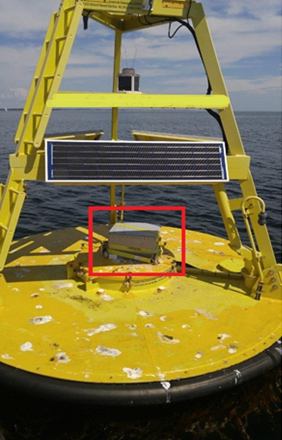Brizo Product Testing: Halifax Harbour

In 2017, Xeos finished design and production of a new product called the Brizo. The Brizo is a GNSS (Global Navigation Satellite System) based wave height sensor meant to be installed on existing buoy infrastructure or added to a buoy as an extra sensor.
Why make a wave sensor product?
The idea came from a gap in the market of wave sensors where no solutions existed for a low-cost, standalone sensor that could be added after a buoy install. Most sensors on the market at the time consisted of accelerometers, pressure- based sensors and doppler profilers. These sensors were commonly integrated into full buoy packages, costing tens of thousands of dollars. Xeos wanted to introduce a disruptive product that would give customers a chance to use their existing infrastructure to collect wave data.
Using GNSS vs an accelerometer in a wave sensor allows flexibility in where the sensor can be placed, which is why it can be installed after the buoy is deployed. Since accelerometers need to be in the center of gravity to work properly, it is not an option to install them in a buoy meant for other uses. The only stipulation with the Brizo is that the GNSS antenna needs to be placed at the top of the buoy, with a clear view of the sky. This feature allows for flexibility in mounting and the opportunity to use the sensor on navigation buoys and scientific buoys alike.
Testing: Brizo 1
After the product was finalized and testing completed, it was time to test the Brizo against an industry standard model. We’ll call this model “Sensor A”. The accelerometer-based platform had been deployed in the Halifax Harbour for some time and proven to work, so it was a good baseline to use for data comparison. Xeos deployed 2 Brizo units for this test - one was co-located on the wave buoy (Brizo 1) and the other was deployed on a navigational buoy roughly 700m away (Brizo 2). The goal of the test was to prove the Brizo would gather accurate data when deployed on a navigational buoy, & could be installed on an existing platform.

Brizo 1 was installed on the wave sensor platform that also housed Sensor A. This platform was a 3 metre disc buoy that was specifically designed for Sensor A. This was a good platform to test the Brizo, since we knew the data coming from Sensor A would be accurate, and a good baseline to compare our data to. The purpose of deploying one of the Brizos on the same structure as an accelerometer-based sensor was to not only show relation in data, but also to compare robustness in design and ease of deployment. The direct comparison shows a large degree of agreement between the two sensors. This test confirms the validity of using GNSS-based wave height sensors agreeing with previous findings.
Testing: Brizo 2
Brizo 2 was installed on a navigational buoy in the Halifax Harbour. This installation was meant to compare the performance of the Brizo between an oceanographic buoy and an existing navigation buoy. The goal was to prove that the Brizo is a viable option on either platform.

Results
The findings of the field test were favourable for both Brizo units that were deployed. The graph below (Graph 1) shows the relationship in significant wave height measured between Brizo 1 and Sensor A. Both data lines track very close together, which proves that the Brizo can work on an oceanographic buoy designed to measure wave statistics. The Brizo mimicked the Sensor A position as closely as possible, and the data was agreeable. There is a small window of data not used in the comparison; these data points were used for post-processing for another application.

The other test was compared the data from Brizo 2 to Sensor A. The second graph (Graph 2) provides a comparison of significant wave height data between Brizo 2 and Sensor A.
Again, the data is agreeable and tracks closely together. There are some slight differences, which can be attributed to the change in wave field from 700m distance between them, buoy size & shape, and GNSS antenna offset. All of these things considered, Brizo 2 provided a successful field test of this theory.

To conclude, it was determined that both Brizo sensors measured accurate data on both types of buoys.
Xeos was very confident in the results of this field test and was able to bring the Brizo sensor to market with this data to rely on. Other tests have been conducted since, with different manufacturers’ sensors on other platforms and similar trends have been found.
There was an in-depth statistical analysis done on this data accompanied by a scientific paper that can be found here:
